#Prince Edward Theatre
Explore tagged Tumblr posts
Text

Diners at the former Prince Edward Theatre, now the London Casino, where they enjoy a full course meal and entertainment. London, 10th December 1938
Photo by Kurt Hutton
31 notes
·
View notes
Text
Pic Hounds
On December 13, a London Instagram user got particularly lucky:

The person behind this account is an unapologetic pic hound. Something beyond my abilities (I am, believe it or not, painfully shy and incredibly awkward in similar situations) and a rather dubious claim to fame. But I am not here to dissect an online career, heh.
The quick snapshot was taken in front of the Prince Edward Theatre, on Old Compton Street, in LHR's Soho. How do I know it?

Then, literally two clicks in order to find out where this play is on for a limited season (and featuring Joseph Fiennes 🤭🧨 - now we are talking business) :

Of course, questions immediately fused: was he alone? yes? no? with whom? who took the pic? She answers he was with a guy (a friend) who took the pic. As an aside, spare the Israeli Peaker who asked first out of Levantine curiosity, I suppose, both accounts insisting are private and have a curiously limited audience. One is clearly a sock account and the other (also being sorry he wasn't 'with a co-star': no shit, Sherlock, I have no clue who you are talking about!), rather questionable credentials for a 'fashion blog'. I really, really wish these people would stop asking altogether, as the answer will always, always be either partial or downright false, at this point in time. Plus, seriously now: how pathetic is this, anyway?
Unlike other times, this pic hound offered even an unsolicited narrative to introduce her story:
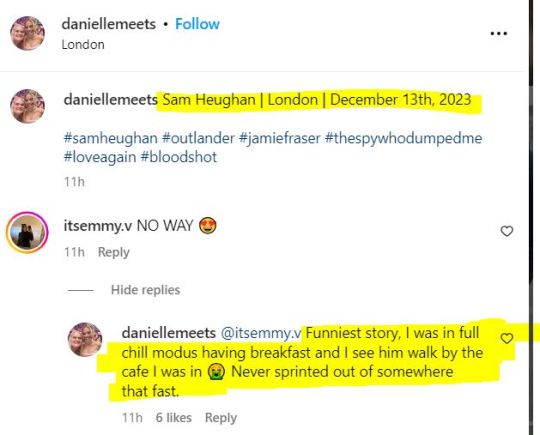
She was 'having breakfast', dear soul, and lo and behold, peekaboo. Maps are wonderful tools, don't you think?
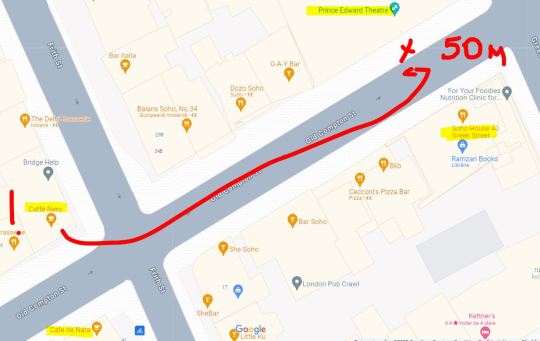
If x marks the spot, where was Danielle having breakfast, allowing her to be simultaneously able to spot SRH and to sprint like Abebe Bikila, breathlessly asking for a pic?
The only possible guess would be the Caffè Nero, at 43 Frith Street. It was open since 06:30, last Wednesday, it has a modicum of terrace outside (unsure if in winter, though) and it is definitely at a sprintable distance from the theatre.
Best part?

It's a three minute (leisure) walk from Soho House, on Dean Street.
I will not have the insolence to ask if the pic hound has a day job, though. That is none of my business, really.
126 notes
·
View notes
Text

Aimee’s 2023 royal family engagement count: The final results!
Disclaimer; everyone’s counts will be different, people have different rules to their method of counting the Court Circular. It isn’t a definitive count and is done just for fun 💗
The court circular doesn’t record any work behind the scenes, only public engagements, official meetings and luncheons/dinners. It’s more a gauge of their public facing roles.
👑 Princess Anne 👑
Once again Princess Anne tops the chart as the hardest working royal, completing 467 engagements.
She has done 393 engagements in the UK.
She travelled to 10 different countries this year and did 74 engagements there. 🇨🇾🇪🇪🇳🇿🇦🇺🇫🇷🇨🇦🇩🇪🇯🇪🇮🇳🇬🇮
Dubbed by some as the unofficial Queen of Scots she did 62 in Scotland.
King Charles III
In the first year of his reign King Charles did a grand total of 463 engagements
In the UK he did 386 engagements.
He travelled to 5 different countries where he completed 76 engagements and did 3 full royal tours in Germany, France and Kenya. He also hosted a state visit for South Korea at Buckingham Palace. 🇩🇪🇷🇴🇫🇷🇰🇪🇦🇪
What is also worth mentioning is that he has Red Boxes that he has to go through every single day, except Christmas Day and Easter Sunday as well as a lot of work behind the scenes.
Prince Edward, The Duke of Edinburgh
This year, on his 59th birthday, Prince Edward became the Duke of Edinburgh, taking the title of his father. With this he increased his work with the Duke of Edinburgh award and travelling to visit international sections of the award. Prince Edward also visited a lot of theatre related organisations and youth centres and charities.
He completed 294 this year and visited 13 countries on solo tours and with his wife. 🇹🇨🇧��🇺🇸🇨🇦🇩🇪🇨🇿🇮🇪🇹🇷🇧🇭🇸🇬🇳🇿🇦🇺🇮🇩
Sophie, The Duchess of Edinburgh
In 2023 Sophie carried on her hard work in areas like women’s rights in disadvantaged areas, avoidable blindness, hygiene and agriculture.
She completed 226 this year in the UK and the commonwealth and visited 10 countries on solo tours and with her husband. 🇳🇱🇹🇨🇧🇸🇮🇶🇮🇹🇪🇹🇨🇦🇨🇴🇨🇭
Prince Richard, The Duke of Gloucester
The Duke of Gloucester has this year completed 208 engagements in the UK.
He continued his long lasting work in heritage, architecture, the St John’s Ambulance and military organisations.
Hopefully next year we will see him do some overseas engagements. 🕯️
Queen Camilla
In the year of her Coronation, Queen Camilla carried out 198 engagements.
She visited Germany, France and Kenya where she did 42 engagements whilst on official tours. 🇩🇪🇫🇷🇰🇪
She focused a lot of her engagements this year on sectors close to her heart like women’s & children’s charities, osteoporosis care and animal welfare.
Prince William, The Prince of Wales
The Prince of Wales this year carried out engagements in the UK and the Commonwealth in areas like mental health, homelessness and conservation. In 2023 he did 183 engagements.
Prince William travelled to 4 countries where he did 32 engagements related to Earthshot in USA and Singapore, visiting Ukrainian troops in Poland, attending the Jordanian royal wedding in June and finally travelling to Kuwait to give his condolences to to The Emir of Kuwait following the death of The Emir Nawaf Al-Ahmad Al-Jaber Al-Sabah. 🇵🇱🇺🇸🇯🇴🇸🇬🇰🇼
Catherine, The Princess of Wales
The Princess of Wales carried out 134 engagements throughout 2023. Catherine continued her work in her Early Years foundation and childhood development.
She visited France for two, one off engagements for the rugby World Cup in France and to Jordan for Crown Prince Hussein and Princess Rajwa’s wedding in June. 🇫🇷🇯🇴
Hopefully we will see her and the Prince of Wales go on a couple of overseas tours next year now that their children are older.
Birgitte, The Duchess of Gloucester
The Duchess of Gloucester has this year completed 127 engagements in the UK. She continued her long lasting work in sports, the arts (Opera, Ballet, Acting etc…) and accompanying her husband to official engagements.
Vice Admiral Sir Tim Laurence
Although not an official working royal, Sir Tim often attends as a great support to his wife’s engagements as well as having his own non-royal patronages and interests. It was recently announced that he would become chair of the Science Museum group and is the patron of a number of heritage organisations.
He accompanied his wife to a total of 92, represented her 4 times and accompanied her to 27 engagements abroad in 5 countries. 🇪🇪🇳🇿🇦🇺🇫🇷🇬🇮
(Operation working royal Tim) 👏
Prince Edward, The Duke of Kent.
Despite being 88, Prince Edward, the late Queens cousin, has carried out 75 engagements even with his ailing mobility.
He continued his valued hard work with organisations like the RNLI, the Royal Scots Guards and the Commonwealth War Graves Commission, which he recently passed on the presidency to the Princess Royal.
Princess Alexandra of Kent
Although she is practically retired now, we have seen Princess Alexandra attend four official engagements in 2023. Firstly she attended a Reception for British East and South-East Asian Communities, secondly to present medals to members of The Royal Lancers, thirdly she attended the Coronation of King Charles and Queen Camilla and lastly she visited the Royal Chelsea Flower Show.
This year the British Royal Family completed a grand total of 2476 in the UK and 29 different countries across the world.
🇨🇾🇪🇪🇳🇿🇦🇺🇫🇷🇨🇦🇩🇪🇯🇪🇮🇳🇬🇮🇷🇴🇰🇪🇵🇱🇺🇸🇯🇴🇸🇬🇹🇨🇧🇸🇨🇿🇹🇷🇧🇭🇸🇬🇮🇩🇳🇱🇮🇶🇮🇹🇪🇹🇨🇴🇨🇭🇰🇼
See below for engagements from the past decade and the types of engagements carried out in 2023


#thank you for following me on this journey#i might carry on in 2024#time will tell#king charles iii#queen camilla#william prince of wales#catherine princess of wales#prince edward duke of edinburgh#sophie duchess of edinburgh#princess anne#princess royal#tim laurence#timothy laurence#prince richard duke of gloucester#birgitte duchess of gloucester#prince edward duke of kent#princess alexandra of kent#2023 engagement count
76 notes
·
View notes
Text
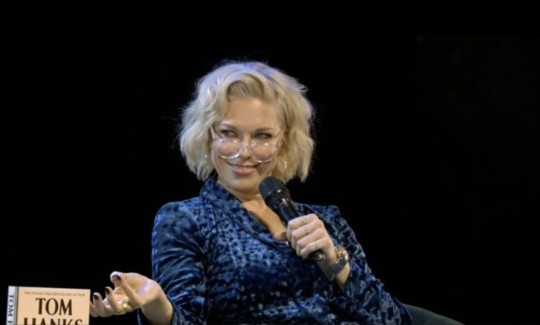
Hannah Waddingham hosting "An Evening with Tom Hanks" at the Prince Edward Theatre tonight
#mommy? sorry#i mean fuck me#I'm barely functioning right now#hannah waddingham#tom hanks#i love them together and cant wait to watch the whole thing#an evening with tom hanks#i love that he fangirls over her#like you know she was absolutely losing her shit#and her suit?? the hair?? the shoes?? fuck
126 notes
·
View notes
Text


BUCKINGSIM PALACE - THE INTERIOR
A Royal Residence owned by The Crown. Buckingsim House was built by Sir George Sussex, 1st Earl of Buckingsim in 1842 and purchased in 1858 by Edward I. The royal family added additional wings, renamed it Buckingsim Palace, and in 1860 it became the new Royal residence and the official administrative headquarters of the Windenburg monarchy.

FLOOR 1: Grand Entrance, Bow Room, Grand Staircase, Picture Gallery, Gym, White Drawing Room, Press Briefing Room, The Grand Ballroom, The State Dining Room, Kitchen, Staff Offices, Staff Living Quarters.

FLOOR 2: Yellow Drawing Room, Music Room, Balcony Room, Throne Room, Private Audience Chambers, Private Chambers of The Queen and Prince consort, Private Apartments of Senior members of the Royal Family, Library.

FLOOR 3: Private Apartments of members and children of the Royal Family, (8) Guest Rooms, Game Room, Theatre Hall, Artifact Room.

FLOOR 4: Photo Studio, Additional Guest Rooms, access to the roof.
(The Exterior)
FAQ below 💜
#simshousewindsor#simshousewindsor royal residence#the interior... 3 years later LOL#simshousewindsor ts4#simshousewindsor history#simshousewindsor royalty#simshousewindsor Buckingsim Palace#ts4#simshousewindsor monarchy#simblr#simshousewindsor simblr#sims 4 monarchy#sims 4 royal family#ts4 royalty#ts4 simblr#simshousewindsor look back#ts4 history#the sims 4 royalty#Coldham Creative
27 notes
·
View notes
Text





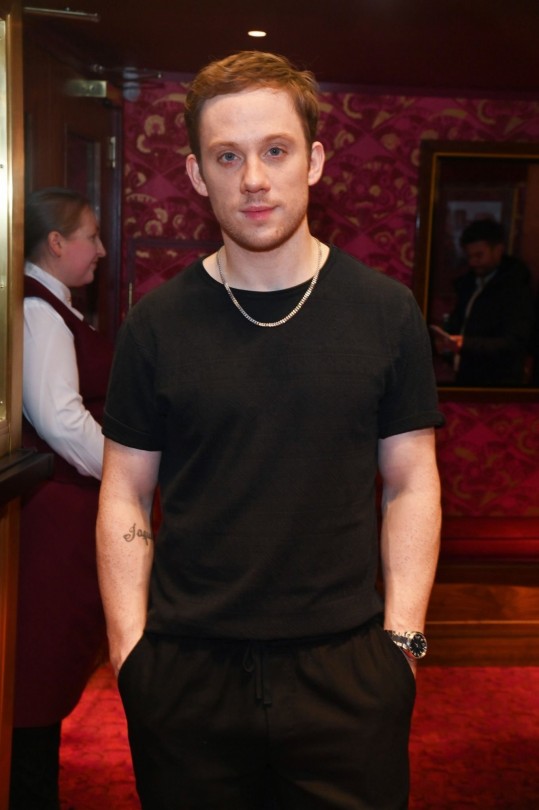

Joe Cole attends the press night performance of "Dear England" at The Prince Edward Theatre on October 19, 2023 in London, England.
#actor#peaky blinders#joe cole#john shelby#gangs of london#sean wallace#skins uk#peakyblindersedit#british actors#events#hang the dj#black mirror#against the ice#the ipcress file#a small light
79 notes
·
View notes
Text
When @paexgo-rosa asked me about the meanings of the Disney Princes names, I wasn't able to give one for Cinderella's Prince, because the Disney version doesn't name him.
I don't like to call him Prince Charming: that's just a cultural nickname for all fairy tale princes.
Fortunately, there are plenty of other Cinderella adaptations that do give the prince a name, so I thought I'd share those names' meanings.
Christopher (his name in every version of Rodgers and Hammerstein's musical, and presumably Disney's 2015 film too, since "Kit" is usually short for Christopher): "Bearer of Christ."
Henry (his name in the Faerie Tale Theatre adaptation and the film Ever After: A Cinderella Story): "Home ruler."
Charles (the film The Glass Slipper and the anime Cinderella Monogatari): "Free man."
Charmont (Massenet's opera Cendrillon and the book and film Ella Enchanted): "Charming."
Ramiro (Rossini's opera La Cenerentola): "Renowned councilor" or "great judge."
Arthur (the Muppets' Hey, Cinderella!): "Bear" or "bear king."
Edward (the film The Slipper and the Rose): "Wealthy guard."
John (the anime My Favorite Fairy Tales): "God is gracious."
Felipe (the series Happily Ever After: Fairy Tales for Every Child): "Horse lover."
Nicolo (the musical A Tale of Cinderella): "Victory of the people."
Leonhard (the Märchenperlen adaptation): "Brave as a lion."
Viktor (the Sechs auf einen Streich adaptation): "Victorious."
Theodore (Deutscher's opera): "Gift from God."
Sebastian (Lloyd Webber's musical): "Revered."
Robert (the Sony/Amazon movie musical): "Bright fame."
For that matter, let's look at the meanings of his full name in the Rodgers and Hammerstein musical:
Christopher Rupert Windermere Vladimir Karl Alexander Francois Reginald Lancelot Herman Gregory James
Christopher: "Bearer of Christ."
Rupert: "Bright fame."
Windermere: "Winand's lake."
Vladimir: "Great ruler" or "peaceful ruler."
Karl: "Free man."
Alexander: "Defender of mankind."
Francois: "Frenchman."
Reginald: "Ruler's advisor."
Lancelot: "Javelin" or "servant."
Herman: "Army man."
Gregory: "Vigilant."
James: "Heel-grabber" or "supplanter."
36 notes
·
View notes
Text

“After Storm in the Fen”, 2024, Oil on canvas

"Squall Lines", 2024, Oil on canvas
For Rachel MacFarlane’s exhibition, Coming Events Cast Their Light Before Them, at Hollis Taggart, she has painted several dreamlike landscapes based on her travels to places impacted by climate events. She first creates maquettes from her observations (three are on view) and then uses them as the basis for the paintings.
From the press release-
At its core, MacFarlane’s work is about lamenting the loss of specific landscapes through creating and depicting new worlds where humans are no longer the protagonists. MacFarlane spends much of her time immersed in unique geographical environments – often ones that have been heavily impacted by climate change-related weather events. While working on her newest body of work, MacFarlane spent extensive time in places ranging from the Adirondacks to Wolfe’s Neck Woods State Park in Maine, and from Prince Edward Island right after it had been hit by Hurricane Fiona to Clearwater, Manitoba during unprecedented flooding. As has always been her practice, MacFarlane does not document while she travels, instead preferring to absorb the atmosphere of a place and spend time really immersed in its sights and sounds. Upon returning to her studio, MacFarlane transforms her observations into three-dimensional maquettes created out of paper, paint, and plastic.
As MacFarlane describes it, a lot of play takes place at her collage table, as she manufactures new spaces based loosely on the spirit of specific ones, drawing on a myriad of influences from theatre and architecture to the world-building of science fiction literature and movies. The paintings in this show were specifically influenced by MacFarlane’s research into the Augsburg Book of Miracles, a manuscript depicting celestial and weather phenomena made in Augsburg, Germany in the sixteenth century. MacFarlane was moved and inspired by how these anonymous illustrators centuries before her were also dedicated to tracking warning signs in the landscape and to recording them in creative ways.
While she describes the model-building as a distancing method, it is also one that creates intimacy, as the scale shift to a shallow box model leads to the creation of a miniature world we can literally hold in our hands versus the enormity of the environment. After MacFarlane distills the memory of a place into an object, she further transforms it into its final form on the canvas, using bold colors and thick brushwork that highlights the painterliness and artifice of her landscapes. As art critic Barry Schwabsky notes in the catalogue essay, these multiple translations and transformations allow MacFarlane to “operate with and against flatness and depth, illusion and physicality, naturalness and theatricality… Her work gives pleasure but also warns that with all these unavoidable antitheses, the choice of one pole or the other would be hopeless, and we have to learn to live with the tensions between them.”
This exhibition closes 5/25/24.
#Rachel MacFarlane#Hollis Taggart NYC#Art#Hollis Taggart#Art Shows#NYC Art Shows#Chelsea Art Galleries#Chelsea Art Shows#Climate Change#Climate Events#Environmental Art#Maquette#New York Art Shows#Painting#Augsburg Book of Miracles
26 notes
·
View notes
Text
Winter Reading Challenge
Every season I like to give myself a challenge to read. Unfortunately, I didn't manage to finish almost any of the ones I had in the autumn challenge (I'm not a procrastinator, I swear, I just have very little free time). This time, I tried to include in the list books from several fields, from prose to poetry, philosophy, theater and theater theory, biographies. There are many Russian authors in this list, it seems to me that they fit very well with the cold season. Let's hope that this time I will stick to reading more. Wish me luck!
From December 1st - February 29th (European calendar)
Leo Tolstoy – ”Childhood. Boyhood. Youth”
Leo Tolstoy – ”War and Peace”
Fyodor Dostoevsky – ”The Double” (1846)
Fyodor Dostoevsky – ”Demons”
Ivan Turghenev – ”Rudin”
Nikolai Leskov – ”Lady Macbeth of Mtsensk and other short stories”
Anton Chekhov – ”Novellas and novelettes by Anton Chekhov”
Nikolai Gogol – ”Dead Souls”
Aleksandr Solzhenitsyn – ”One Day in the Life of Ivan Denisovich”
Mikhail Bulgakov – ”The Master and Margarita”
Maxim Gorky – ”Mother”
Vladimir Nabokov – ”Lolita”
Marguerite Yourcenar - "A Coin in Nine Hands"
Marguerite Yourcenar - "A Blue Tale"
Franz Kafka - "The Metamorphosis and other stories"
Edgar Allan Poe - "The Narrative of Arthur Gordon Pym of Nantucket"
John Edwards Williams - "Stoner"
Ovid - "Metamorphoses"
Dante Aligheri - "The Divine Comedy - Inferno"
Giovanni Papini - "Gog"
Plato - "Phaedo"
Aristotel - "Metaphysics "
Marcus Aurelius - "Meditations: Thoughts to Myself"
Immanuel Kant - "Prolegomena to Any Future Metaphysics Article Talk "
Niccolo Machiavelli - "The Prince"
Emil Cioran - "The Trouble With Being Born"
Peter Brook - "The Empty Space"
Jerzy Grotowski - "The Poor Theatre"
Antonin Artaud - "The Theatre and its Double"
Martin Esslin - "The Theatre of Absurd"
Salvador Dalí - "Diary of a Genius"
Vaslav Nijinsky - "The Diary of Vaslav Nijinsky: Unexpurgated Edition"
August Strindberg - "The Ghost Sonata"
William Shakespeare - "Titus Andronicus"
William Shakespeare - "Coriolanus"
Maxim Gorky - "The Lower Depths"
Racine - "Britannicus"
Goethe - "Gotz von Berlichingen"
Frank Wedekind - "The Spring Awakening"
Aeschylus - "The Oresteia" (Agamemnon, The Libation Bearers, The Eumenides)
#dark academia#books and reading#bookblr#book#booklr#books#reading list#winter#russian writers#biography#philosophy#reading challenge#theatre plays#theatre#poetry
50 notes
·
View notes
Text
(Mostly) Lost, but Not Forgotten: Omar Khayyam (1923) / A Lover’s Oath (1925)


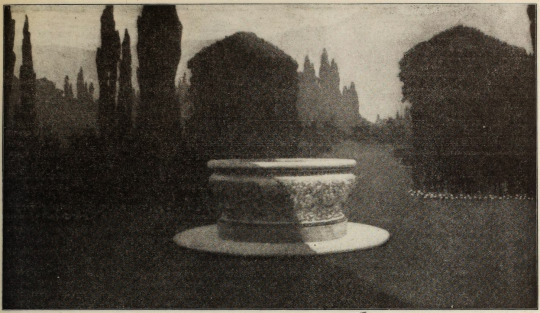
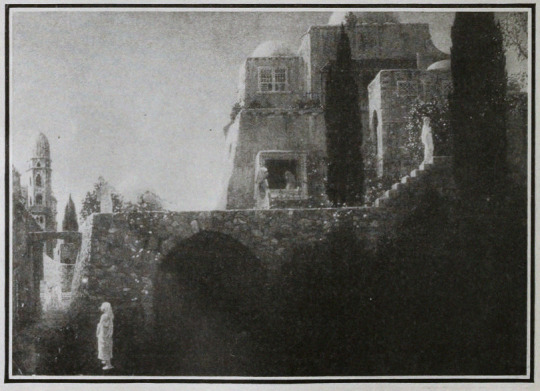
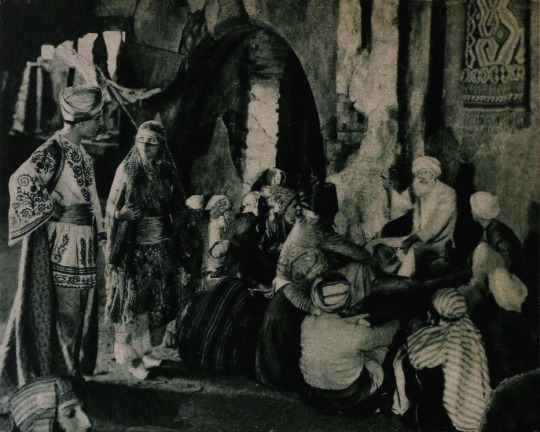
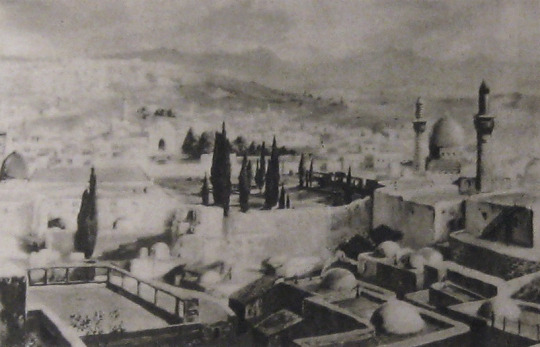
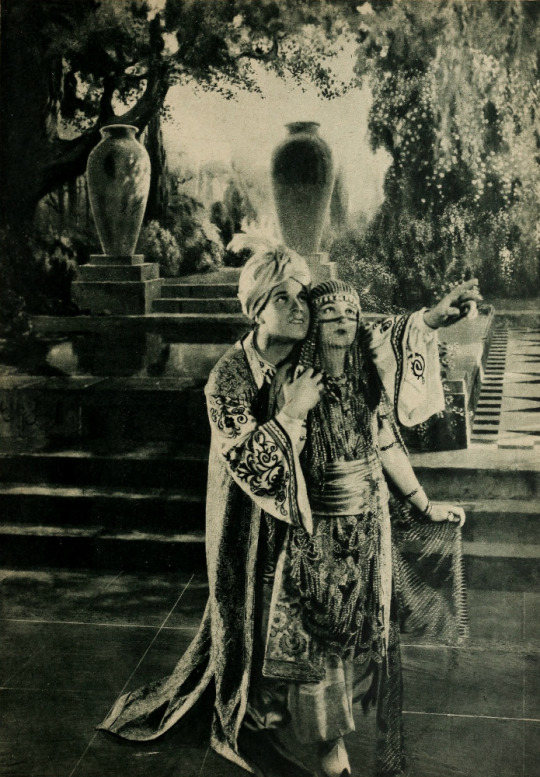
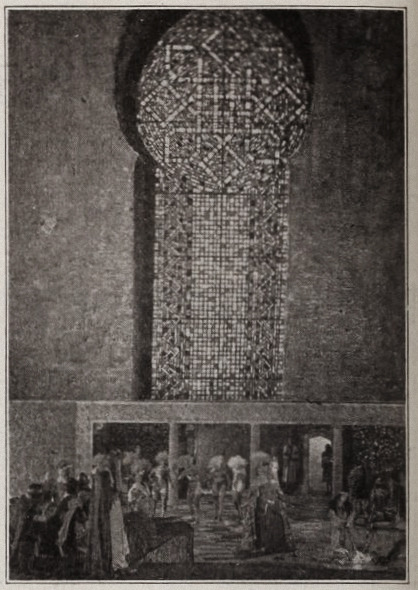
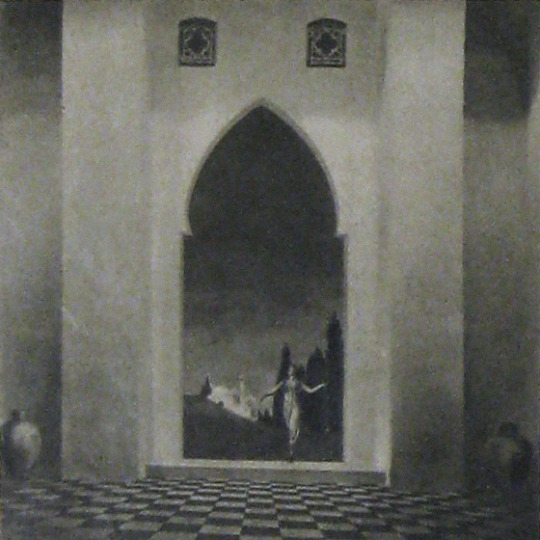
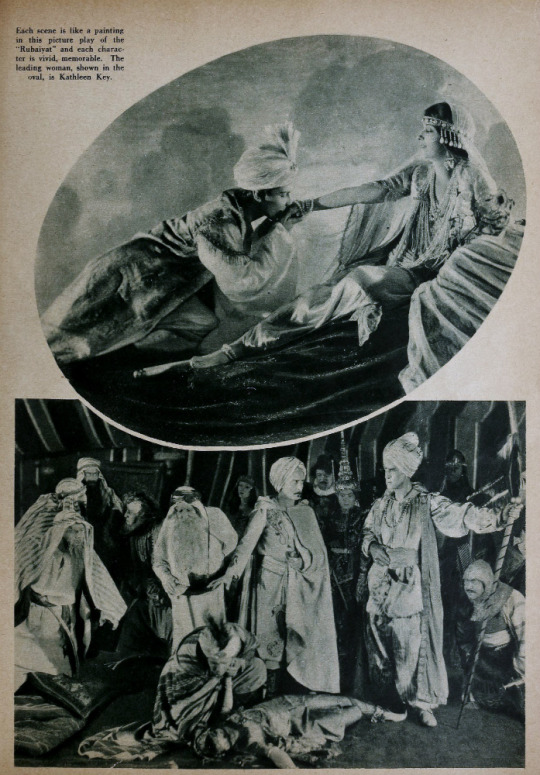



Alternate Titles: The Rubaiyat of Omar Khayyam, The Rubaiyat, Omar Khayyam, Omar
Direction: Ferdinand Pinney Earle; assisted by Walter Mayo
Scenario: Ferdinand P. Earle
Titles: Marion Ainslee, Ferdinand P. Earle (Omar), Louis Weadock (A Lover’s Oath)
Inspired by: The Rubaiyat of Omar Khayyam, as edited & translated by Edward FitzGerald
Production Manager: Winthrop Kelly
Camera: Georges Benoit
Still Photography: Edward S. Curtis
Special Photographic Effects: Ferdinand P. Earle, Gordon Bishop Pollock
Composer: Charles Wakefield Cadman
Editors: Arthur D. Ripley (The Rubaiyat of Omar Khayyam version), Ethel Davey & Ferdinand P. Earle (Omar / Omar Khayyam, the Director’s cut of 1922), Milton Sills (A Lover’s Oath)
Scenic Artists: Frank E. Berier, Xavier Muchado, Anthony Vecchio, Paul Detlefsen, Flora Smith, Jean Little Cyr, Robert Sterner, Ralph Willis
Character Designer: Louis Hels
Choreography: Ramon Novarro (credited as Ramon Samaniegos)
Technical Advisors: Prince Raphael Emmanuel, Reverend Allan Moore, Captain Dudley S. Corlette, & Captain Montlock or Mortlock
Studio: Ferdinand P. Earle Productions / The Rubaiyat, Inc. (Production) & Eastern Film Corporation (Distribution, Omar), Astor Distribution Corporation [States Rights market] (Distribution, A Lover’s Oath)
Performers: Frederick Warde, Edwin Stevens, Hedwiga Reicher, Mariska Aldrich, Paul Weigel, Robert Anderson, Arthur Carewe, Jesse Weldon, Snitz Edwards, Warren Rogers, Ramon Novarro (originally credited as Ramon Samaniegos), Big Jim Marcus, Kathleen Key, Charles A. Post, Phillippe de Lacy, Ferdinand Pinney Earle
Premiere(s): Omar cut: April 1922 The Ambassador Theatre, New York, NY (Preview Screening), 12 October 1923, Loew’s New York, New York, NY (Preview Screening), 2 February 1923, Hoyt’s Theatre, Sydney, Australia (Initial Release)
Status: Presumed lost, save for one 30 second fragment preserved by the Academy Film Archive, and a 2.5 minute fragment preserved by a private collector (Old Films & Stuff)
Length: Omar Khayyam: 8 reels , 76 minutes; A Lover’s Oath: 6 reels, 5,845 feet (though once listed with a runtime of 76 minutes, which doesn’t line up with the stated length of this cut)
Synopsis (synthesized from magazine summaries of the plot):
Omar Khayyam:
Set in 12th century Persia, the story begins with a preface in the youth of Omar Khayyam (Warde). Omar and his friends, Nizam (Weigel) and Hassan (Stevens), make a pact that whichever one of them becomes a success in life first will help out the others. In adulthood, Nizam has become a potentate and has given Omar a position so that he may continue his studies in mathematics and astronomy. Hassan, however, has grown into quite the villain. When he is expelled from the kingdom, he plots to kidnap Shireen (Key), the sheik’s daughter. Shireen is in love with Ali (Novarro). In the end it’s Hassan’s wife (Reicher) who slays the villain then kills herself.
A Lover’s Oath:
The daughter of a sheik, Shireen (Key), is in love with Ali (Novarro), the son of the ruler of a neighboring kingdom. Hassan covets Shireen and plots to kidnap her. Hassan is foiled by his wife. [The Sills’ edit places Ali and Shireen as protagonists, but there was little to no re-shooting done (absolutely none with Key or Novarro). So, most critics note how odd it is that all Ali does in the film is pitch woo, and does not save Shireen himself. This obviously wouldn’t have been an issue in the earlier cut, where Ali is a supporting character, often not even named in summaries and news items. Additional note: Post’s credit changes from “Vizier” to “Commander of the Faithful”]
Additional sequence(s) featured in the film (but I’m not sure where they fit in the continuity):
Celestial sequences featuring stars and planets moving through the cosmos
Angels spinning in a cyclone up to the heavens
A Potters’ shop sequence (relevant to a specific section of the poems)
Harem dance sequence choreographed by Novarro
Locations: palace gardens, street and marketplace scenes, ancient ruins
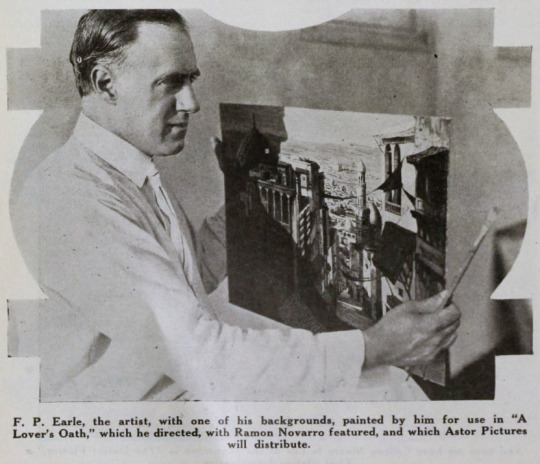

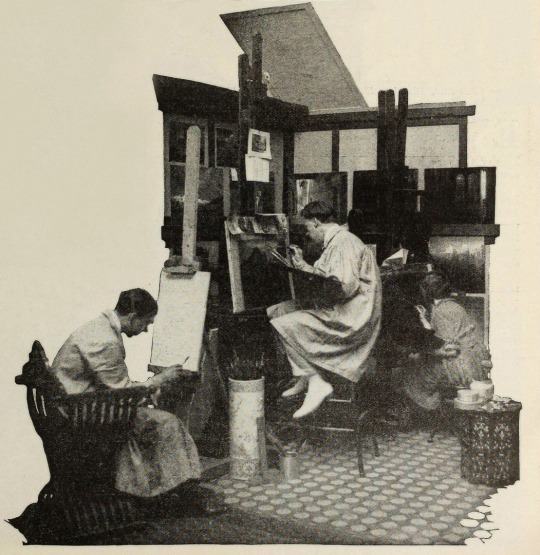
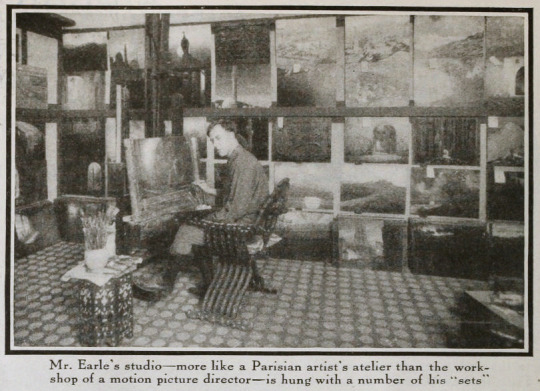
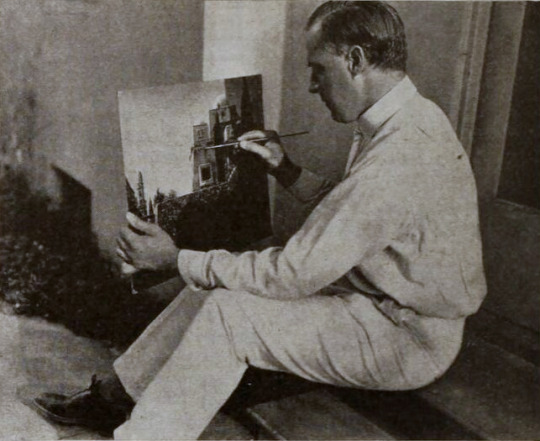
Points of Interest:
“The screen has been described as the last word in realism, but why confine it there? It can also be the last word in imaginative expression.”
Ferdinand P. Earle as quoted in Exhibitors Trade Review, 4 March 1922
The Rubaiyat of Omar Khayyam was a massive best seller. Ferdinand Pinney Earle was a classically trained artist who studied under William-Adolphe Bougueraeu and James McNeill Whistler in his youth. He also had years of experience creating art backgrounds, matte paintings, and art titles for films. Charles Wakefield Cadman was an accomplished composer of songs, operas, and operettas. Georges Benoit and Gordon Pollock were experienced photographic technicians. Edward S. Curtis was a widely renowned still photographer. Ramon Novarro was a name nobody knew yet—but they would soon enough.
When Earle chose The Rubaiyat as the source material for his directorial debut and collected such skilled collaborators, it seemed likely that the resulting film would be a landmark in the art of American cinema. Quite a few people who saw Earle’s Rubaiyat truly thought it would be:
William E. Wing writing for Camera, 9 September 1922, wrote:
“Mr. Earle…came from the world of brush and canvass, to spread his art upon the greater screen. He created a new Rubaiyat with such spiritual colors, that they swayed.” … “It has been my fortune to see some of the most wonderful sets that this Old Earth possesses, but I may truly say that none seized me more suddenly, or broke with greater, sudden inspiration upon the view and the brain, than some of Ferdinand Earle’s backgrounds, in his Rubaiyat. “His vision and inspired art seem to promise something bigger and better for the future screen.”
As quoted in an ad in Film Year Book, 1923:
“Ferdinand Earle has set a new standard of production to live up to.”
Rex Ingram
“Fifty years ahead of the time.”
Marshall Neilan
The film was also listed among Fritz Lang’s Siegfried, Chaplin’s Gold Rush, Fairbanks’ Don Q, Lon Chaney’s Phantom of the Opera and The Unholy Three, and Erich Von Stroheim’s Merry Widow by the National Board of Review as an exceptional film of 1925.
So why don’t we all know about this film? (Spoiler: it’s not just because it’s lost!)
The short answer is that multiple dubious legal challenges arose that prevented Omar’s general release in the US. The long answer follows BELOW THE JUMP!
Earle began the project in earnest in 1919. Committing The Rubaiyat to film was an ambitious undertaking for a first-time director and Earle was striking out at a time when the American film industry was developing an inferiority complex about the level of artistry in their creative output. Earle was one of a number of artists in the film colony who were going independent of the emergent studio system for greater protections of their creative freedoms.
In their adaptation of The Rubaiyat of Omar Khayyam, Earle and Co. hoped to develop new and perfect existing techniques for incorporating live-action performers with paintings and expand the idea of what could be accomplished with photographic effects in filmmaking. The Rubaiyat was an inspired choice. It’s not a narrative, but a collection of poetry. This gave Earle the opportunity to intersperse fantastical, poetic sequences throughout a story set in the lifetime of Omar Khayyam, the credited writer of the poems. In addition to the fantastic, Earle’s team would recreate 12th century Persia for the screen.
Earle was convinced that if his methods were perfected, it wouldn’t matter when or where a scene was set, it would not just be possible but practical to put on film. For The Rubaiyat, the majority of shooting was done against black velvet and various matte photography and multiple exposure techniques were employed to bring a setting 800+ years in the past and 1000s of miles removed to life before a camera in a cottage in Los Angeles.
Note: If you’d like to learn a bit more about how these effects were executed at the time, see the first installment of How’d They Do That.
Unfortunately, the few surviving minutes don’t feature much of this special photography, but what does survive looks exquisite:
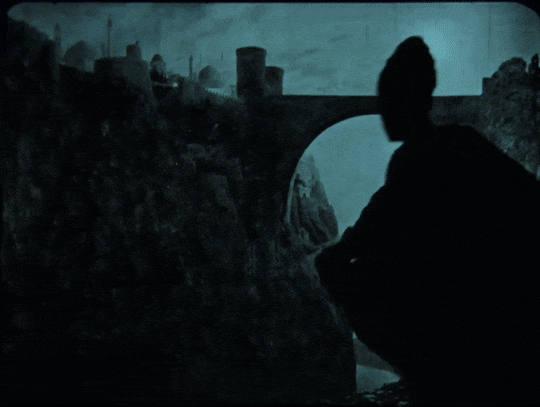
see all gifs here
Earle, knowing that traditional stills could not be taken while filming, brought in Edward S. Curtis. Curtis developed techniques in still photography to replicate the look of the photographic effects used for the film. So, even though the film hasn’t survived, we have some pretty great looking representations of some of the 1000s of missing feet of the film.
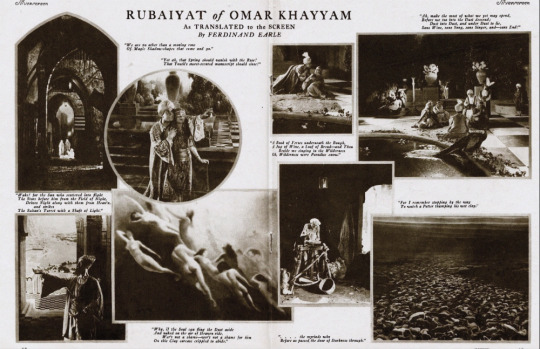
Nearly a year before Curtis joined the crew, Earle began collaboration with composer Charles Wakefield Cadman. In another bold creative move, Cadman and Earle worked closely before principal photography began so that the score could inform the construction and rhythm of the film and vice versa.
By the end of 1921 the film was complete. After roughly 9 months and the creation of over 500 paintings, The Rubaiyat was almost ready to meet its public. However, the investors in The Rubaiyat, Inc., the corporation formed by Earle to produce the film, objected to the ample reference to wine drinking (a comical objection if you’ve read the poems) and wanted the roles of the young lovers (played by as yet unknown Ramon Novarro and Kathleen Key) to be expanded. The dispute with Earle became so heated that the financiers absconded with the bulk of the film to New York. Earle filed suit against them in December to prevent them from screening their butchered and incomplete cut. Cadman supported Earle by withholding the use of his score for the film.
Later, Eastern Film Corp. brokered a settlement between the two parties, where Earle would get final cut of the film and Eastern would handle its release. Earle and Eastern agreed to change the title from The Rubaiyat of Omar Khayyam to simply Omar. Omar had its first official preview in New York City. It was tentatively announced that the film would have a wide release in the autumn.
However, before that autumn, director Norman Dawn launched a dubious patent-infringement suit against Earle and others. Dawn claimed that he owned the sole right to use multiple exposures, glass painting for single exposure, and other techniques that involved combining live action with paintings. All the cited techniques had been widespread in the film industry for a decade already and eventually and expectedly Dawn lost the suit. Despite Earle’s victory, the suit effectively put the kibosh on Omar’s release in the US.
Earle moved on to other projects that didn’t come to fruition, like a Theda Bara film and a frankly amazing sounding collaboration with Cadman to craft a silent-film opera of Faust. Omar did finally get a release, albeit only in Australia. Australian news outlets praised the film as highly as those few lucky attendees of the American preview screenings did. The narrative was described as not especially original, but that it was good enough in view of the film’s artistry and its imaginative “visual phenomena” and the precision of its technical achievement.
One reviewer for The Register, Adelaide, SA, wrote:
“It seems almost an impossibility to make a connected story out of the short verse of the Persian of old, yet the producer of this classic of the screen… has succeeded in providing an entertainment that would scarcely have been considered possible. From first to last the story grips with its very dramatic intensity.”
While Omar’s American release was still in limbo, “Ramon Samaniegos” made a huge impression in Rex Ingram’s Prisoner of Zenda (1922, extant) and Scaramouche (1923, extant) and took on a new name: Ramon Novarro. Excitement was mounting for Novarro’s next big role as the lead in the epic Ben-Hur (1925, extant) and the Omar project was re-vivified.
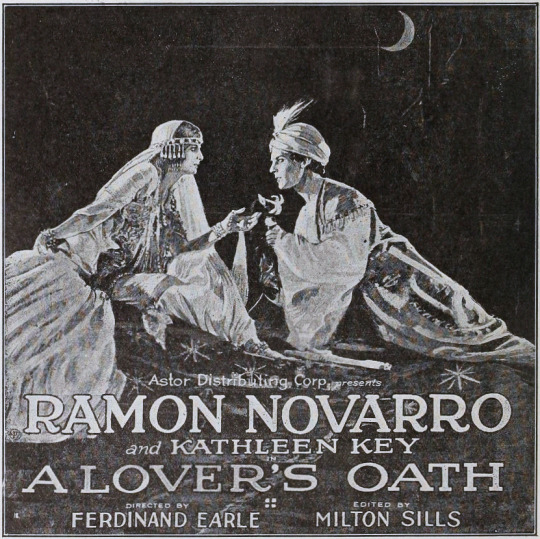
A new company, Astor Distribution Corp., was formed and purchased the distribution rights to Omar. Astor hired actor (note, not an editor) Milton Sills to re-cut the film to make Novarro and Key more prominent. The company also re-wrote the intertitles, reduced the films runtime by more than ten minutes, and renamed the film A Lover’s Oath. Earle had moved on by this point, vowing to never direct again. In fact, Earle was indirectly working with Novarro and Key again at the time, as an art director on Ben-Hur!
Despite Omar’s seemingly auspicious start in 1920, it was only released in the US on the states rights market as a cash-in on the success of one of its actors in a re-cut form five years later.
That said, A Lover’s Oath still received some good reviews from those who did manage to see it. Most of the negative criticism went to the story, intertitles, and Sills’ editing.
What kind of legacy could/should Omar have had? I’m obviously limited in my speculation by the fact that the film is lost, but there are a few key facts about the film’s production, release, and timing to consider.
The production budget was stated to be $174,735. That is equivalent to $3,246,994.83 in 2024 dollars. That is a lot of money, but since the production was years long and Omar was a period film set in a remote locale and features fantastical special effects sequences, it’s a modest budget. For contemporary perspective, Robin Hood (1922, extant) cost just under a million dollars to produce and Thief of Bagdad (1924, extant) cost over a million. For a film similarly steeped in spectacle to have nearly 1/10th of the budget is really very noteworthy. And, perhaps if the film had ever had a proper release in the US—in Earle’s intended form (that is to say, not the Sills cut)—Omar may have made as big of a splash as other epics.
It’s worth noting here however that there are a number of instances in contemporary trade and fan magazines where journalists off-handedly make this filmmaking experiment about undermining union workers. Essentially implying that that value of Earle’s method would be to continue production when unionized workers were striking. I’m sure that that would absolutely be a primary thought for studio heads, but it certainly wasn’t Earle’s motivation. Often when Earle talks about the method, he focuses on being able to film things that were previously impossible or impracticable to film. Driving down filming costs from Earle’s perspective was more about highlighting the artistry of his own specialty in lieu of other, more demanding and time-consuming approaches, like location shooting.
This divide between artists and studio decision makers is still at issue in the American film and television industry. Studio heads with billion dollar salaries constantly try to subvert unions of skilled professionals by pursuing (as yet) non-unionized labor. The technical developments of the past century have made Earle’s approach easier to implement. However, just because you don’t have to do quite as much math, or time an actor’s movements to a metronome, does not mean that filming a combination of painted/animated and live-action elements does not involve skilled labor.
VFX artists and animators are underappreciated and underpaid. In every new movie or TV show you watch there’s scads of VFX work done even in films/shows that have mundane, realistic settings. So, if you love a film or TV show, take the effort to appreciate the work of the humans who made it, even if their work was so good you didn’t notice it was done. And, if you’ve somehow read this far, and are so out of the loop about modern filmmaking, Disney’s “live-action” remakes are animated films, but they’ve just finagled ways to circumvent unions and low-key delegitimize the skilled labor of VFX artists and animators in the eyes of the viewing public. Don’t fall for it.
VFX workers in North America have a union under IATSE, but it’s still developing as a union and Marvel & Disney workers only voted to unionize in the autumn of 2023. The Animation Guild (TAG), also under the IATSE umbrella, has a longer history, but it’s been growing rapidly in the past year. A strike might be upcoming this year for TAG, so keep an eye out and remember to support striking workers and don’t cross picket lines, be they physical or digital!
Speaking of artistry over cost-cutting, I began this post with a mention that in the early 1920s, the American film industry was developing an inferiority complex in regard to its own artistry. This was in comparison to the European industries, Germany’s being the largest at the time. It’s frustrating to look back at this period and see acceptance of the opinion that American filmmakers weren’t bringing art to film. While yes, the emergent studio system was highly capitalistic and commercial, that does not mean the American industry was devoid of home-grown artists.
United Artists was formed in 1919 by Douglas Fairbanks, Charlie Chaplin, Mary Pickford, and D.W. Griffith precisely because studios were holding them back from investing in their art—within the same year that Earle began his Omar project. While salaries and unforgiving production schedules were also paramount concerns in the filmmakers going independent, a primary impetus was that production/distribution heads exhibited too much control over what the artists were trying to create.
Fairbanks was quickly expanding his repertoire in a more classical and fantastic direction. Cecil B. DeMille made his first in a long and very successful string of ancient epics. And the foreign-born children of the American film industry, Charlie Chaplin, Rex Ingram, and Nazimova, were poppin’ off! Chaplin was redefining comedic filmmaking. Ingram was redefining epics. Nazimova independently produced what is often regarded as America’s first art film, Salome (1923, extant), a film designed by Natacha Rambova, who was *gasp* American. Earle and his brother, William, had ambitious artistic visions of what could be done in the American industry and they also had to self-produce to get their work done.
Meanwhile, studio heads, instead of investing in the artists they already had contracts with, tried to poach talent from Europe with mixed success (in this period, see: Ernst Lubitsch, F.W. Murnau, Benjamin Christensen, Mauritz Stiller, Victor Sjöström, and so on). I’m in no way saying it was the wrong call to sign these artists, but all of these filmmakers, even if they found success in America, had stories of being hired to inject the style and artistry that they developed in Europe into American cinema, and then had their plans shot down or cut down to a shadow of their creative vision. Even Stiller, who tragically died before he had the opportunity to establish himself in the US, faced this on his first American film, The Temptress (1926, extant), on which he was replaced. Essentially, the studio heads’ actions were all hot air and spite for the filmmakers who’d gone independent.
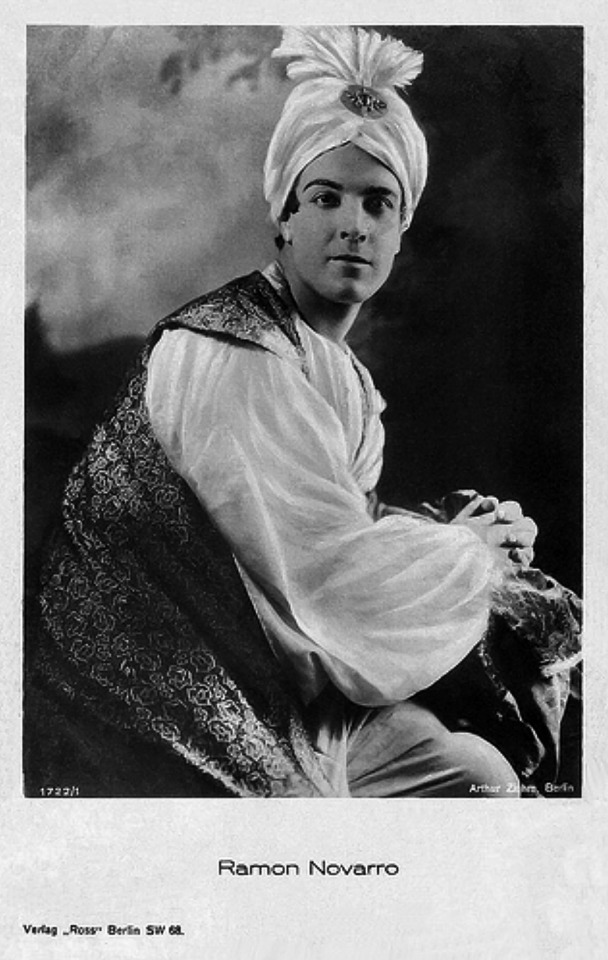
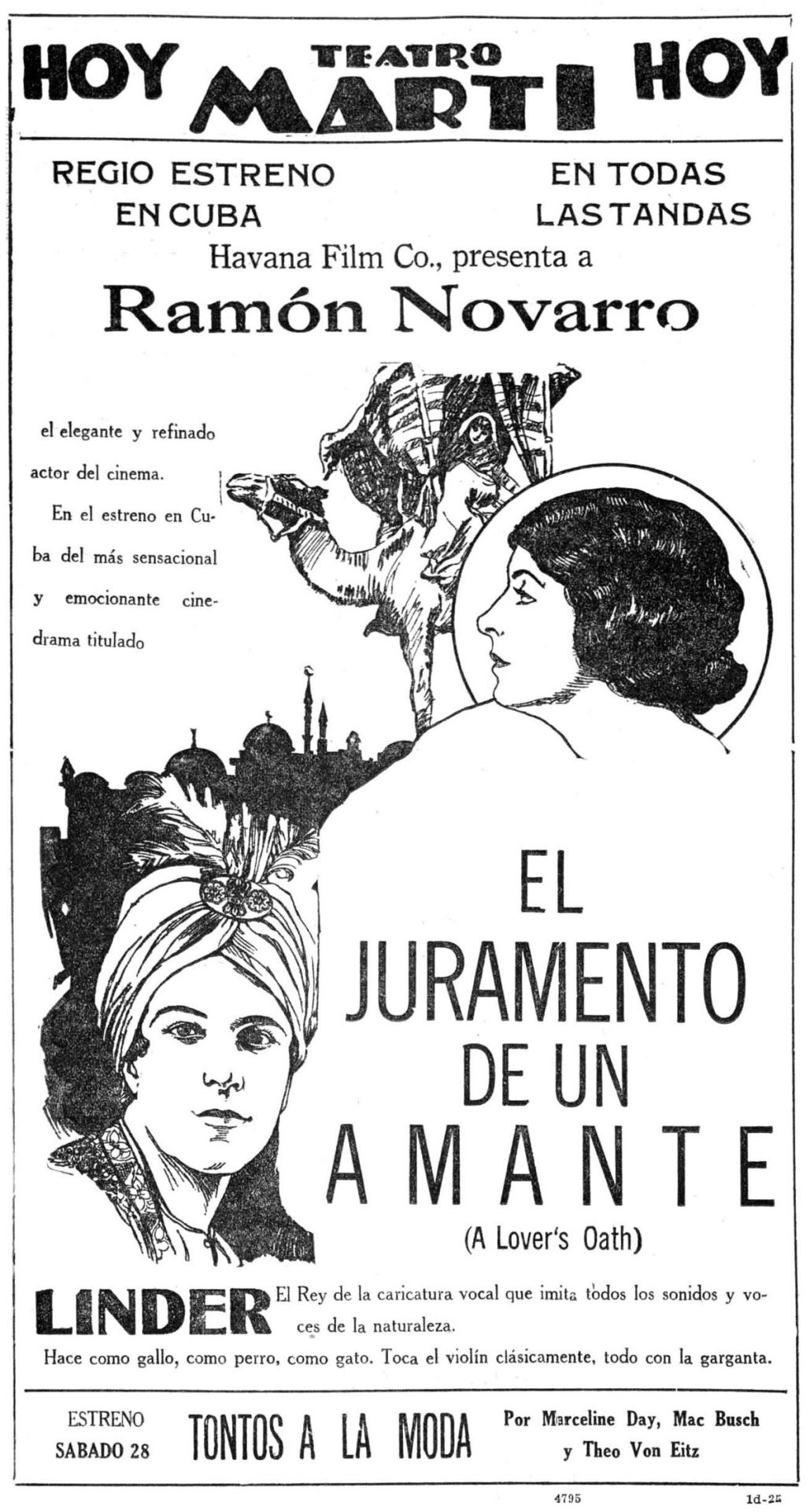
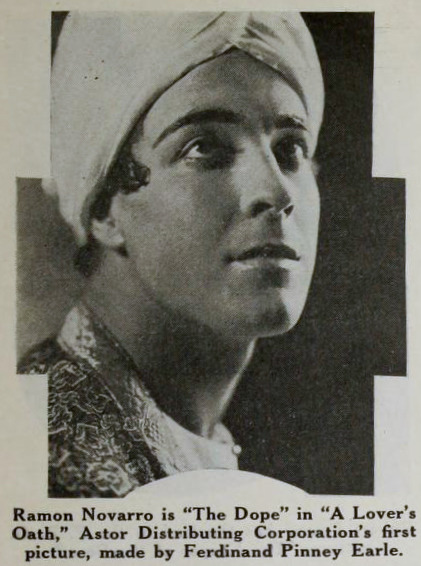
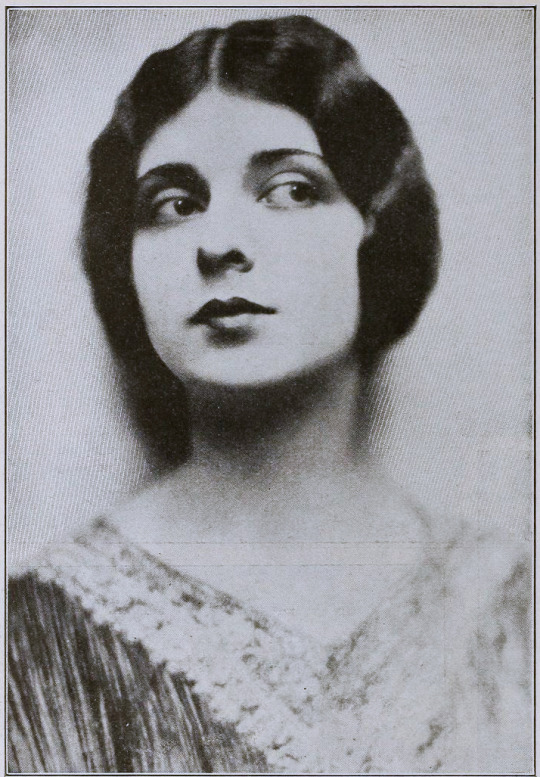

Finally I would like to highlight Ferdinand Earle’s statement to the industry, which he penned for from Camera in 14 January 1922, when his financial backers kidnapped his film to re-edit it on their terms:
MAGNA CHARTA
Until screen authors and producers obtain a charter specifying and guaranteeing their privileges and rights, the great slaughter of unprotected motion picture dramas will go merrily on.
Some of us who are half artists and half fighters and who are ready to expend ninety per cent of our energy in order to win the freedom to devote the remaining ten per cent to creative work on the screen, manage to bring to birth a piteous, half-starved art progeny.
The creative artist today labors without the stimulus of a public eager for his product, labors without the artistic momentum that fires the artist’s imagination and spurs his efforts as in any great art era.
Nowadays the taint of commercialism infects the seven arts, and the art pioneer meets with constant petty worries and handicaps.
Only once in a blue moon, in this matter-of-fact, dollar-wise age can the believer in better pictures hope to participate in a truely [sic] artistic treat.
In the seven years I have devoted to the screen, I have witnessed many splendid photodramas ruined by intruding upstarts and stubborn imbeciles. And I determined not to launch the production of my Opus No. 1 until I had adequately protected myself against all the usual evils of the way, especially as I was to make an entirely new type of picture.
In order that my film verison [sic] of the Rubaiyat of Omar Khayyam might be produced under ideal conditions and safeguarded from intolerable interferences and outside worries, I entered into a contract with the Rubaiyat, Inc., that made me not only president of the corporation and on the board of directors, but which set forth that I was to be author, production manager, director, cutter and film editor as well as art director, and that no charge could be made against the production without my written consent, and that my word was to be final on all matters of production. The late George Loane Tucker helped my attorney word the contract, which read like a splendid document.
Alas, I am now told that only by keeping title to a production until it is declared by yourself to be completed is it safe for a scenario writer, an actor or a director, who is supposedly making his own productions, to contract with a corporation; otherwise he is merely the servant of that corporation, subject at any moment to discharge, with the dubious redress of a suit for damages that can with difficulty be estimated and proven.
Can there be any hope of better pictures as long as contracts and copyrights are no protection against financial brigands and bullies?
We have scarcely emerged from barbarism, for contracts, solemnly drawn up between human beings, in which the purposes are set forth in the King’s plainest English, serve only as hurdles over which justice-mocking financiers and their nimble attorneys travel with impunity, riding rough shod over the author or artist who cannot support a legal army to defend his rights. The phrase is passed about that no contract is invioliable [sic]—and yet we think we have reached a state of civilization!
The suit begun by my attorneys in the federal courts to prevent the present hashed and incomplete version of my story from being released and exhibited, may be of interest to screen writers. For the whole struggle revolves not in the slightest degree around the sanctity of the contract, but centers around the federal copyright of my story which I never transferred in writing otherwise, and which is being brazenly ignored.
Imagine my production without pictorial titles: and imagine “The Rubaiyat” with a spoken title as follows, “That bird is getting to talk too much!”—beside some of the immortal quatrains of Fitzgerald!
One weapon, fortunately, remains for the militant art creator, when all is gone save his dignity and his sense of humor; and that is the rapier blade of ridicule, that can send lumbering to his retreat the most brutal and elephant-hided lord of finance.
How edifying—the tableau of the man of millions playing legal pranks upon men such as Charles Wakefield Cadman, Edward S. Curtis and myself and others who were associated in the bloody venture of picturizing the Rubaiyat! It has been gratifying to find the press of the whole country ready to champion the artist’s cause.
When the artist forges his plowshare into a sword, so to speak, he does not always put up a mean fight.
What publisher would dare to rewrite a sonnet of John Keats or alter one chord of a Chopin ballade?
Creative art of a high order will become possible on the screen only when the rights of established, independent screen producers, such as Rex Ingram and Maurice Tourneur, are no longer interferred with and their work no longer mutilated or changed or added to by vandal hands. And art dramas, conceived and executed by masters of screen craft, cannot be turned out like sausages made by factory hands. A flavor of individuality and distinction of style cannot be preserved in machine-made melodramas—a drama that is passed from hand to hand and concocted by patchworkers and tinkerers.
A thousand times no! For it will always be cousin to the sausage, and be like all other—sausages.
The scenes of a master’s drama may have a subtle pictorial continuity and a power of suggestion quite like a melody that is lost when just one note is changed. And the public is the only test of what is eternally true or false. What right have two or three people to deprive millions of art lovers of enjoying an artist’s creation as it emerged from his workshop?
“The Rubaiyat” was my first picture and produced in spite of continual and infernal interferences. It has taught me several sad lessons, which I have endeavored in the above paragraphs to pass on to some of my fellow sufferers. It is the hope that I am fighting, to a certain extent, their battle that has given me the courage to continue, and that has prompted me to write this article. May such hubbubs eventually teach or inforce a decent regard for the rights of authors and directors and tend to make the existence of screen artisans more secure and soothing to the nerves.
FERDINAND EARLE.
---
☕Appreciate my work? Buy me a coffee! ☕
Transcribed Sources & Annotations over on the WMM Blog!
See the Timeline for Ferdinand P. Earle's Rubaiyat Adaptation
#1920s#1923#1925#omar khayyam#ferdinand pinney earle#ramon novarro#independent film#american film#silent cinema#silent era#silent film#classic cinema#classic movies#classic film#film history#history#Charles Wakefield Cadman#cinematography#The Rubaiyat#cinema#film#lost film
49 notes
·
View notes
Text
Prince Edward, Duke of Edinburgh
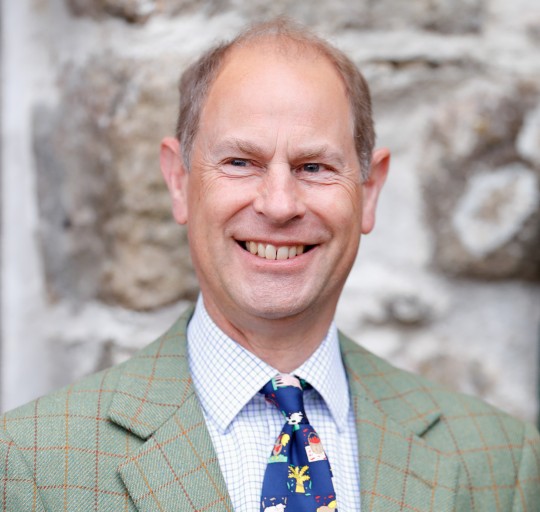
Physique: Average Build Height: 6'0" (183 cm)
Prince Edward, Duke of Edinburgh, KG, GCVO, CD, ADC (Edward Antony Richard Louis; born 10 March 1964-) is a member of the British royal family. He is the youngest child of Queen Elizabeth II and Prince Philip, Duke of Edinburgh, and the youngest sibling of King Charles III. He was born 3rd in the line of succession to the British throne and is now 14th.

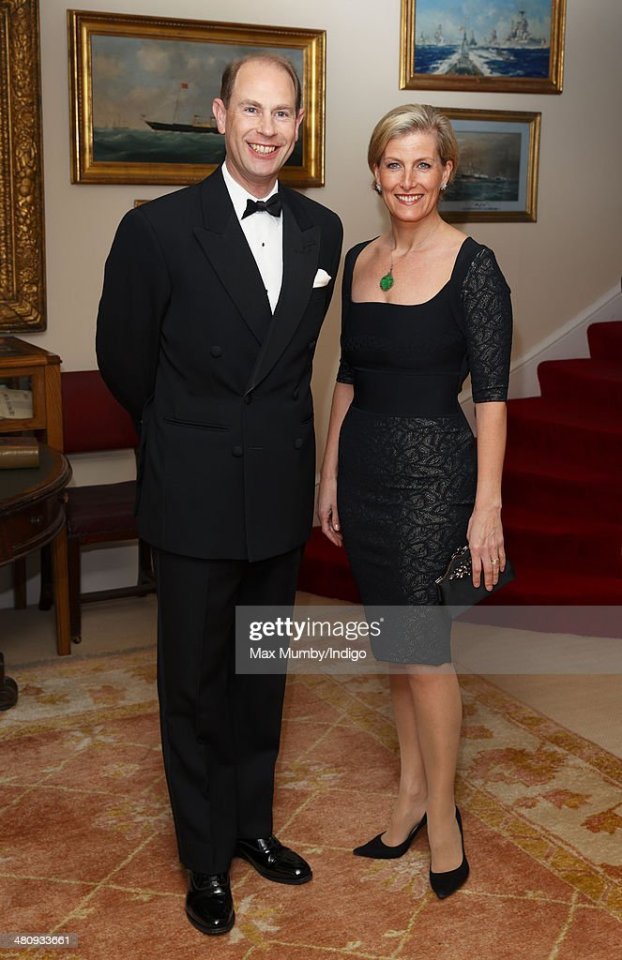
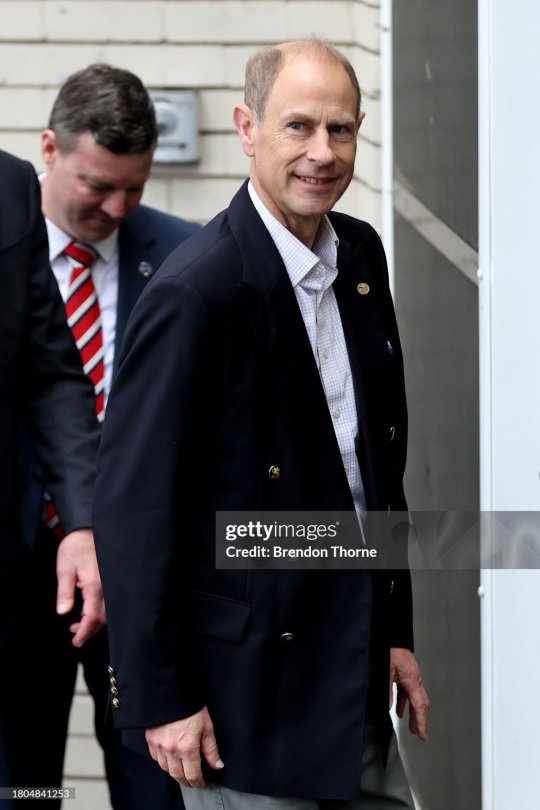


While not as desirable as Charles or Andrew, Edward does has something I’m finding attractive. Apparently in his youth, he was by far the most attractive British Royal to some and pinged to high heaven. What? He did work in theatre.
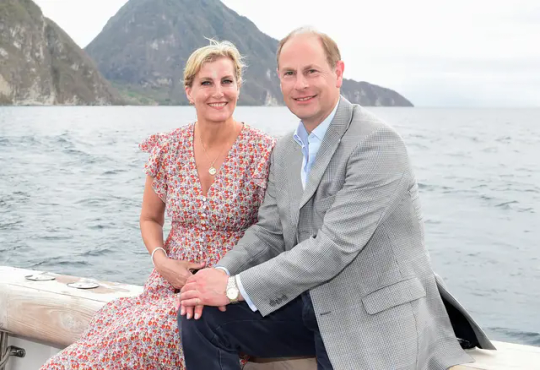

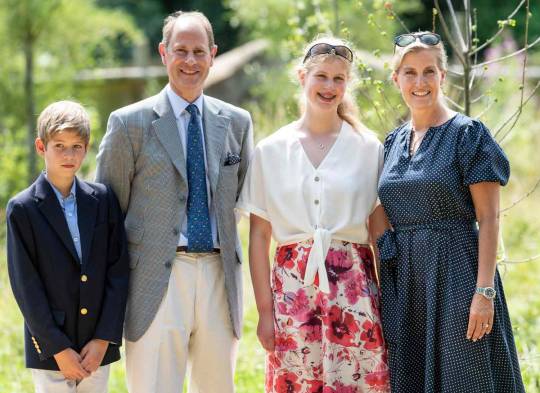
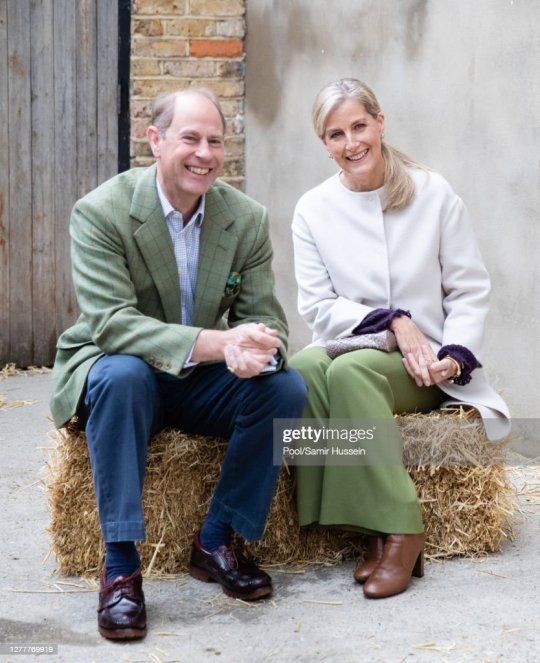
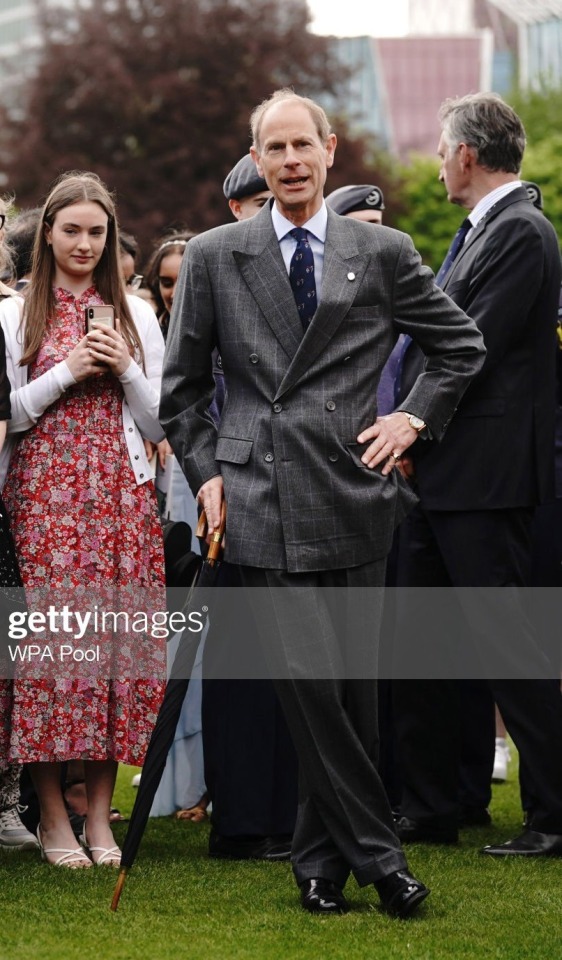
Married with two children, back in the early 90's, it's rumored he and some singer/actor were an item. Apparently it was the worst kept secret in town. Now with his parents are gone, his brother, King Charles III on a tear to economize the BRF and his other brother is a disgrace. Can Prince Edward finally live his true life? Rekindle the magic with his first real love? Keep a hot, ripped piece on the side (namely me). Indulge in his love of the (other) BBC without shame.
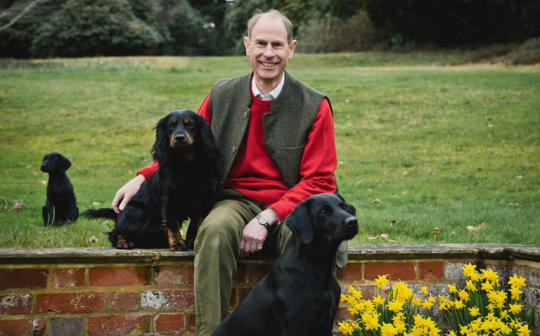
27 notes
·
View notes
Text
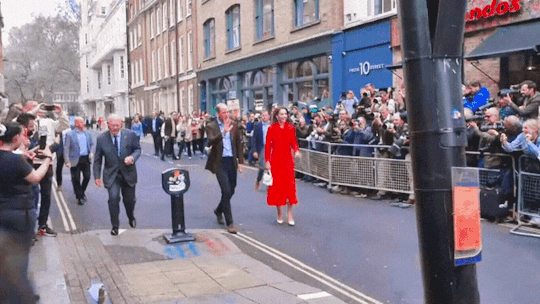






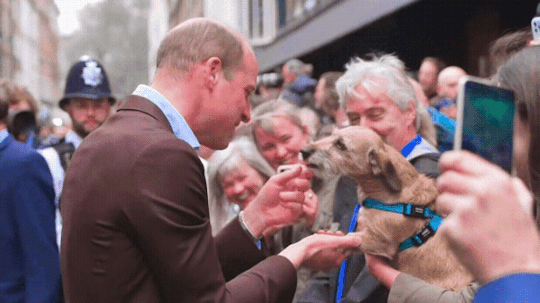

THE WALES DIARIES ♚
4 MAY 2023 || The Dog & Duck Pub, Soho
The Prince and Princess of Wales walked from the distance from Tottenham Court Road to the Dog & Duck pub in Soho.
They visited the Dog & Duck Pub to hear how it's preparing for the coronation weekend from members of staff and to meet representatives from other hospitality and recreation businesses in the area.
William and Catherine talked to managers from local businesses expecting a boom in trade this weekend with extended opening hours for pubs and bars, music and other events. Among them were representatives from nearby Ronnie Scott's jazz club, the Prince Edward Theatre, Bar Italia, and the Randall and Aubin restaurant.
They were then accompanied by pub managers Chris Watts and Maria Sojkova behind the bar, where William poured a 'perfect pint' as per Bernie Kidson, the shift supervisor. This was the first pint of Kingmaker, a pale ale brewed to celebrate the coronation
Following their visit they spent time meeting well-wishers and posing for selfies with them, many of whom were foreign tourists who are in London for the Coronation.
#the wales diaries 23#the wales diaries#the engagement diaries#engagement diaries#engagement diaries 23#4.05.2023#soho visit 23#dog and duck pub 23#british royal family#british royals#royalty#royals#brf#british royalty#kate middleton#catherine middleton#royal#princess of wales#the prince and princess of wales#the prince of wales#prince of wales#prince and princess of wales#the princess of wales#princess catherine#prince william#catherine wales.#william wales.#gifs#my gifs#royalty edit
78 notes
·
View notes
Text
It's a bit frustrating to look at the Aubrey-Maturin tag and be deluged with gifs from the movie. Now I like the movie, it was my introduction the series as giddily presented to me by my grandmother when it hit theatres (her copies of the series are over on my left), and if half of it hadn't been filmed on now-awful-looking 2K digital film, I'd love it even more: the cinematography is excellent. Russel's Crowe's Jack Aubrey is about as good as we are likely to get from Hollywood: he's nowhere near fat enough, he's nowhere near scarred enough, he's not nearly taut enough with his officers and men (because somebody probably complained it made him sound 'mean' if it even reached the script stage—several times in the film he lets his officers give their opinions, which goes against Jack's character), and he honestly not nearly goofy enough (the famous weevil crack is about the most we get), but all in all it's a good performance for a Hollywood flicker and it acquits itself well. It's the Jack in Heroic mode we essentially get throughout, and I get the motivations behind it even if it lacks the complexity of the character I love. But Paul Bettany's performance as Maturin is frustrating. First, its offensive in and of itself to cast as an Irishman an Englishman who is so English his father is godfather to the wife of Prince Edward. You wouldn't know Bettany's Maturin was Irish (much less half-Spanish) if he didn't expressly say so in the picture. For a character so inextricably Irish to just be an Englishman is very vexing. He looks like Stephen Maturin even less than Russel Crowe looks like Jack should: he's much too handsome, much too well-dressed, and far too pleasant. None of Stephen's peevish waspishness makes it into the movie: at best FilmStephen mopes, and none of his cutting wit, far less his erudition, really makes it to the screen. Part of the problem, of course, is the same issue that inflicts every Jane Austen adaptation too: a distinct refusal by the part of filmmakers to depict an era with such a different understanding of intimacy among the upper classes. Even O'Brian struggled with this, as I once heard an interview where a historian complained that in the early books it was downright promiscuous how often O'Brian's characters shook hands. So of course both characters come off as less-formal on screen than they do in the books. But the movie flattens all of Stephen's wrinkles out, leaving him a caricature of his dynamic, prickly, funny, often dangerously drug-hazed, Butcher of Boston, sometimes stuffy, sometimes radical, always sui generis self. It's not a bad performance, Bettany does what he can with the material he's given, but the character on screen is decidedly not Señor Esteban Maturin y Domanova, MD.
#master and commander#Jack Aubrey#stephen maturin#the far side of the world#paul bettany#Russel Crowe#patrick o'brian#Esteban Maturin y Domanova#aubreyad#aubrey-maturin#Jane Austen
25 notes
·
View notes
Text
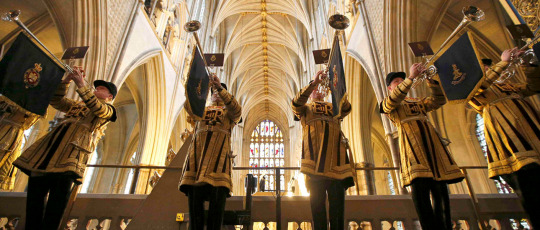
Coronation Music at Westminster Abbey
The Royal Family | Published 18 February 2023
Twelve newly commissioned pieces of music will be performed at The Coronation of Their Majesties The King and The Queen Consort at Westminster Abbey on Saturday 6 May 2023, showcasing musical talent from across the United Kingdom and the Commonwealth.
A range of musical styles and performers blend tradition, heritage and ceremony with new musical voices of today, reflecting The King’s life-long love and support of music and the arts.
His Majesty The King has personally commissioned the new music and shaped and selected the musical programme for the Service.
Andrew Nethsingha, Organist and Master of the Choristers, Westminster Abbey, will be overseeing all musical arrangements and directing the music during the Service.
Sir Antonio Pappano, Music Director for the Royal Opera House, will be conducting the Coronation Orchestra which comprises a bespoke collection of musicians drawn from orchestras of The former Prince of Wales’ Patronages including the Royal Philharmonic Orchestra.
Six orchestral commissions, five choral commissions and one organ commission, have been specially composed for the occasion by world-renowned British composers whose work includes Classical, Sacred, Film, Television and Musical Theatre. Commissioned works include a new Coronation Anthem by Andrew Lloyd Webber, a Coronation March by Patrick Doyle, a new commission for solo organ embracing musical themes from countries across the Commonwealth by Iain Farrington plus new works by Sarah Class, Nigel Hess, Paul Mealor, Tarik O'Regan, Roxanna Panufnik, Shirley J. Thompson, Judith Weir, Roderick Williams, and Debbie Wiseman.
Soloists will include bass-baritone, Sir Bryn Terfel; soprano, Pretty Yende and baritone, Roderick Williams. The organ will be played by Sub-Organist, Westminster Abbey, Peter Holder, and Assistant Organist, Westminster Abbey, Matthew Jorysz.
The official Royal Harpist Alis Huws will perform as part of the Coronation Orchestra in recognition of The King’s long-standing and deeply held relationship and affiliation with Wales. One of the liturgical sections of the ceremony will also be performed in Welsh.
At the request of His Majesty, in tribute to his late father His Royal Highness The Prince Philip, Duke of Edinburgh, Greek Orthodox music will also feature in the Service performed by the Byzantine Chant Ensemble.
The Service will be sung by The Choir of Westminster Abbey and The Choir of His Majesty’s Chapel Royal, St James’s Palace, together with girl choristers from the Chapel Choir of Methodist College, Belfast and from Truro Cathedral Choir. The Ascension Choir, a handpicked gospel choir will also perform as part of the Service and The King’s Scholars of Westminster School will proclaim the traditional ‘Vivat’ acclamations.
Fanfares will be played by The State Trumpeters of the Household Cavalry and The Fanfare Trumpeters of the Royal Air Force.
Sir John Eliot Gardiner will conduct The Monteverdi Choir and English Baroque soloists in a pre-Service programme of choral music. A small group of singers from The Monteverdi Choir will also join the main choral forces for the Service.
Music by the likes of William Byrd (1543–1623), George Frideric Handel (1685–1759), Sir Edward Elgar (1857–1934), Sir Henry Walford Davies (1869–1941), Sir William Walton (1902–1983), Sir Hubert Parry (1848–1918) and Ralph Vaughan Williams (1872–1958) has historically featured in the Service over the past four centuries and will be included in the programme along with the music of one of Britain’s most loved and celebrated living composers, Sir Karl Jenkins.
102 notes
·
View notes
Text
David Tennant audios: Tuesdays & Sundays is an audio gem
As you all know by now, surely, I'm a David Tennant theatre buff, but right now I want to explore my other major passion with regards to his work: his audios. He's done a bewildering amount of audio work and a lot of it is really, really good. With that in mind, I'm going to concentrate on one of my absolute favorite David Tennant audio works: a 2003 audio entitled Tuesdays & Sundays.
Based on a true story of an 1887 series of events between a young woman named Mary Tuplin and her lover William Millman in Margate on Canada’s Prince Edward Island, Tuesdays & Sundays begins with the young couple's spirits as they "awaken into a void. As they question where they are, they recall and begin to relive the story which got them there: their giddy courtship and the overwhelming passions of first love, the pangs of a six-month absence, an unplanned pregnancy, and a guilty and shameful young man amidst a community in which respectability is of utmost importance. As they try to cope, to keep love amongst the fear and confusions of youth, these two spirits ultimately stumble upon their own tragic ending."
Sounds intriguing, yes?
Tuesdays & Sundays was originally a 45-minute play written by Canadians Daniel Arnold and Medina Hahn. It was first performed in June 2000 in Edmonton, Canada, with the authors as the two principal characters William and Mary. Arnold and Hahn took the play on tours throughout Canada, Europe and the US and won many awards, including the Sterling Haynes Award for Outstanding Fringe Performance.
In 2003, Arnold and Hahn were asked to adapt the play for radio; one for Canada's CBC Radio (which starred themselves) and once for the BBC. I spoke to Arnold about how the play got adapted, and he told me, “CBC Radio was the first to approach us about a radio version, and we performed it on CBC Radio with minimal adaptation. The Edinburgh Festival is where Sara Benaim of the BBC saw it, and asked about a radio adaptation for BBC Radio 4. We adapted the play accordingly, and…re-set it to [Tusket in] Nova Scotia, where there was much more Scottish settlement. Margate on Prince Edward Island was much more English. We made…the characters both immigrants from Scotland, which actually worked quite well.”
The BBC adaptation was broadcast on 16 June 2003 as the BBC Radio 4 Afternoon play and starred David as William and Claire Yuille (who later appeared in the first episode of 2010’s Single Father, credited only as a “Doting Mum") as Mary. And on top of all that, David and Claire also voiced all of the play's other minor characters!
Of David’s turn as the young William Millman, Arnold told me, “We were quite taken with his performance in it.” He added, “We were thrilled when we learned David Tennant would play (my role) William…and when we heard the recording on the BBC, it sounded fantastic.”
And it DOES! In my opinion, there are so many reasons why this play is stupendous. David and Claire are top-drawer. The dialogue is back and forth, breathless and imbued with teenaged giddiness, bullet-paced and conversational - both with each other and in asides to themselves - and it must've taken some doing for the two actors to get this pace down just right without running over the top of each other and blurring it into chaos. But instead, it creates a perfect tension-filled atmosphere that draws an audience in and makes this play a must-hear.
By this time I imagine you're wondering where you can hear or read this play. Well, here's a partial script. Here's the original Canadian radio broadcast at the Internet Archive (which is a great listen in and of itself) but, sadly, hearing David's version had become a bit more difficult. The Internet Archive had a copy once but it's been removed, and Arnold and Hahn's DualMinds website has almost 5 minutes of the play, but as it's based in Flash Player good luck getting it to work. But I won't tell if you won't tell - so go get it here while it's still available. ;)
Here's a cute little David in advertising for the play - and below, some other historical information about the events the play is based on. If you don't want to know anything about the play before listening to it (spoilers!) then don't look beyond this photo!

-----
The real Mary Pickering Tuplin was 17 years old when she was murdered, and her lover William Millman was convicted of the crime. Tuplin’s body was pulled from the Southwest River on July 4, 1887, just a short distance from where she lived with her parents in Margate. She had been shot twice in the head. Her body was weighed down with a heavy stone, and it was discovered she had been six months pregnant. Authorities separated her head from her body for forensic examination, and - bizarrely - it was never reunited with her body. It remained in the coroner's office, which eventually became a pharmacy. And there it remained until 2016, when it was finally reburied with the rest of her remains.
If true crime is your thing, you can access the entire report of the Tuplin-Millman murder trial, right here!
William Millman was convicted of Mary Tuplin's murder and was sentenced to hang. Despite the jury’s recommendation for mercy, he was hanged on 10 April 1888.
Many believe him innocent of the crime. Was he? It's highly unlikely we will never know.
26 notes
·
View notes
Note
What is your favorite whump movies or tv shows?
TV shows (non-exhaustive list):
The Fall (season 3 episodes 1-3 (heavy, heavy, perfect med whump))
The Flash (season 1 & 2)
Graceland (specifically season 3, episode 8, but also late season 2 early season 3, and also some smattering in between)
Daredevil (season 1, this has some of the best scenes, like the BEST)
Roswell (season 1, the white room if you like lab whump go on the n*tflix and watch this episode)
Buffy the Vampire Slayer (throughout, but there are a lot of specific scenes that I love)
Spartacus, Blood and Sand (entire first season)
House/ER/Greys/Chicago Med (first handful of seasons, for my med whump)
Outlander (season 1, periodically, but I don't love it generally)
Movies/Scenes from Movies (it should be noted that I much more frequently perseverate on like feel-good light movies, I find that finding truly whumpy movies is rare and my overall preference is for light movies, since whumpy movies usually only have a handful of whumpy scenes and then you have to pay attention to the rest :))
Life Like (I just recently watched this and died 100 times over, it makes zero sense but we just don't look that deep)
Hunger Games Catching Fire (Whipping Scene)
X-Men/Wolverine Movies
Mad Max Fury Road
Papillon
The Shape of Water (nonhuman)
Upgrade
Captain America Winter Soldier
Some Recent Whumpy Reads (you didn't ask for this but I'm on one now)
The Foxhole Court series (easiest whumpiest read, keep your expectations low and get through the end of book 2 before dipping, you won't regret)
A Little Life (check the TW on google before embarking)
The Billionaire Series by Alexis Hall (ok it's not super whumpy but your imagination can really get carried away here)
The Last Sun by KD Edwards (specifically the first book but peachy swears by all 3 currently released)
The Darkness Outside Us
Captive Prince
Happy Head
What else? Whumpy Theatre?
The Inheritance (Toronto, Miami, and Columbus OH coming up if you're interested)
The Book of Mormon
A Little Life
Once on this Island
Life of Pi
Smuta (this is too niche to see right now but maybe one day)
#my greatest passion in life is talking about whump in media#i have lots of niche scene recommendations#but here's the gist#whump recommendations#whump in tv#whump in movies#whump in plays#whump in books#anonymous#thanks for indulging me!#peachy-panic recommends all books to me so if you want one that isn't on this list she's your gal
38 notes
·
View notes